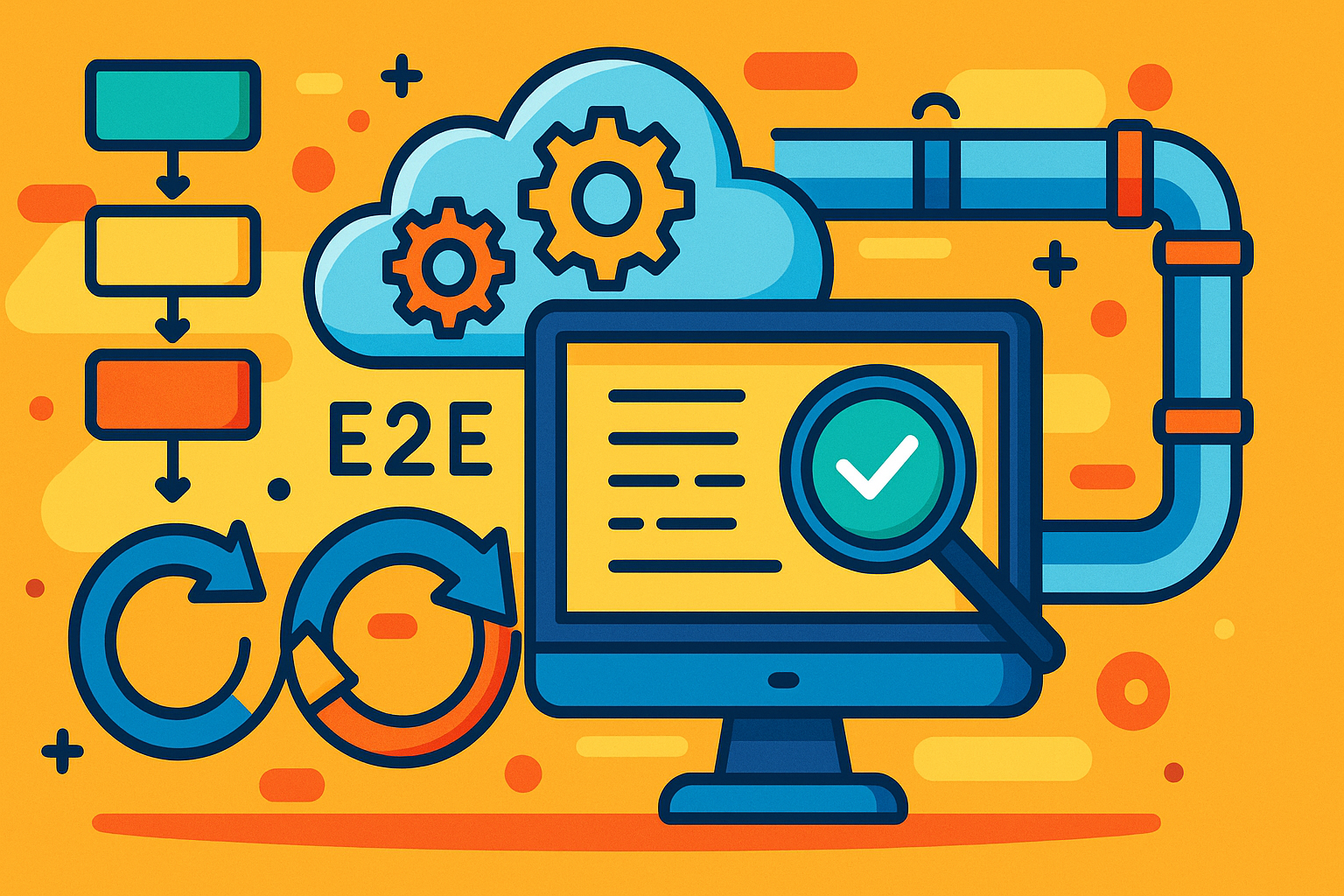
We expect daily life to run smoothly. Our cars start instantly, our coffee brews perfectly, and streaming services play without a hitch. Similarly, today’s digital users have zero patience for software hiccups. To meet these expectations, many businesses now build cloud-native applications, highly scalable, flexible, and agile software. However, while our construction materials have changed, the need for sturdy, reliable software has only grown stronger. This is where End-to-End (E2E) testing comes in, verifying entire user workflows to ensure every software component seamlessly works together.
In this article, you’ll see practical ways to embed E2E tests effectively into your Continuous Integration and Continuous Delivery (CI/CD) pipelines, turning complexity into clarity.
Navigating the challenges of cloud-native testing
Traditional software testing was like assembling a static puzzle on a stable surface. Cloud-native testing, however, feels more like putting together a puzzle on a moving vehicle, every piece constantly shifts.
Complex microservice coordination
Cloud-native apps are often built with multiple microservices, each operating independently. Think of these as specialized workers collaborating on a complex project. If one worker stumbles, the whole project suffers. Microservices require precise coordination, making it tricky to identify and fix issues quickly.
Short-lived and shifting environments
Containers and Kubernetes create ephemeral, constantly changing environments. They’re like pop-up stores appearing briefly and disappearing overnight. Managing testing in these environments means handling dynamic URLs and quickly changing configurations, a challenge comparable to guiding customers to a food truck that relocates every day.
The constant quest for good test data
In dynamic environments, consistently managing accurate test data can feel impossible. It’s akin to a chef who finds their pantry randomly restocked every few minutes. Having fresh and relevant ingredients consistently ready becomes a monumental challenge.
Integrating quality directly into your CI/CD pipeline
Incorporating E2E tests into CI/CD is like embedding precision checkpoints directly onto an assembly line, catching problems as soon as they appear rather than after the entire product is built.
Early detection saves the day
Embedding E2E tests acts like multiple smoke detectors installed throughout a building rather than just one centrally located. Issues get pinpointed rapidly, preventing small problems from becoming massive headaches. Tools like Datadog Synthetic or Cypress allow parallel execution, speeding up the testing process dramatically.
Stopping errors before users see them
Failed E2E tests automatically halt deployments, ensuring faulty code doesn’t reach customers. Imagine a vigilant gatekeeper preventing defective products from leaving the factory, this is exactly how integrated E2E tests protect software quality.
Rapid recovery and reduced downtime
Frequent and targeted testing significantly reduces Mean Time To Repair (MTTR). If a recipe tastes off, testing each ingredient individually makes it easy to identify the problematic one swiftly.
Testing advanced deployment methods
E2E tests validate sophisticated deployment strategies like canary or blue-green deployments. They’re comparable to taste-testing new recipes with select diners before serving them to a broader audience.
Strategies for reliable E2E tests in cloud environments
Conducting E2E tests in the cloud is like performing a sensitive experiment outdoors where weather conditions (network latency, traffic spikes) constantly change.
Fighting flakiness in dynamic conditions
Cloud environments often introduce unpredictable elements, network latency, resource contention, and transient service issues. It’s similar to trying to have a detailed conversation in a loud environment; messages can easily be missed.
Robust test locators
Build your tests to find UI elements using multiple identifiers. If the primary path is blocked, alternate paths ensure your tests remain reliable. Think of it like knowing multiple routes home in case one road gets closed.
Intelligent automatic retries
Implement automatic retries for tests that intermittently fail due to transient issues. Just like retrying a phone call after a bad connection, automated retries ensure temporary problems don’t falsely indicate major faults.
Stability matters for operations
Flaky tests create unnecessary alerts, causing teams to lose confidence in their testing suite. SREs need reliable signals, like a fire alarm that only triggers for genuine fires, not burned toast.
Real-Life integration, an example of a QuickCart application
Imagine assembling a complex Lego model, verifying each piece as it’s added.
E-Commerce application scenario
Consider “QuickCart,” a hypothetical cloud-native e-commerce application with services for product catalog, user accounts, shopping cart, and order processing.
Critical user journey
An essential E2E scenario: a user logs in, searches products, adds one to the cart, and proceeds toward checkout. This represents a common user experience path.
CI/CD pipeline workflow
When a developer updates the Shopping Cart service:
- The CI/CD pipeline automatically builds the service.
- The E2E test suite runs the crucial “Add to Cart” test before deploying to staging.
- Test results dictate the next steps:
- Pass: Change promoted to staging.
- Fail: Deployment halted; team immediately notified.
- Pass: Change promoted to staging.
This ensures a broken cart never reaches customers.
Choosing the right tools and automation
Selecting testing tools is like equipping a kitchen: the right tools significantly ease the task.
Popular E2E frameworks
Tools such as Cypress, Selenium, Playwright, and Datadog Synthetics each bring unique strengths to the table, making it easier to choose one that fits your project’s specific needs. Cypress excels with developer experience, allowing quick test creation. Selenium is unbeatable for extensive cross-browser testing. Playwright offers rapid execution ideal for fast-paced environments. Datadog Synthetics integrates seamlessly into monitoring systems, swiftly identifying potential problems.
Smooth integration with CI/CD
These tools work well with CI/CD platforms like Jenkins, GitLab CI, GitHub Actions, or Azure DevOps, orchestrating your automated tests efficiently.
Configurable and adaptable
Adjusting tests between environments (dev, staging, prod) is as simple as tweaking a base recipe, with minimal effort, and maximum adaptability.
Enhanced observability and detailed reporting
Observability and detailed reporting are the navigational instruments of your testing universe. Tools like Prometheus, Grafana, Datadog, or New Relic highlight test failures and offer valuable context through logs, metrics, and traces. Effective observability reduces downtime and stress, transforming complex debugging from tedious guesswork into targeted, effective troubleshooting.
The path to continuous confidence
Embedding E2E tests into your cloud-native CI/CD pipeline is like learning to cook with cast iron pans. Initial skepticism and maintenance worries soon give way to reliably delicious outcomes. Quick feedback, fewer surprises, and less midnight stress transform software cycles into satisfying routines.
Great software doesn’t happen overnight, it’s carefully seasoned and consistently refined. Embrace these strategies, and software quality becomes not just attainable but deliciously predictable.


